Preventing Ice Damming on Roof and Protecting Your Property
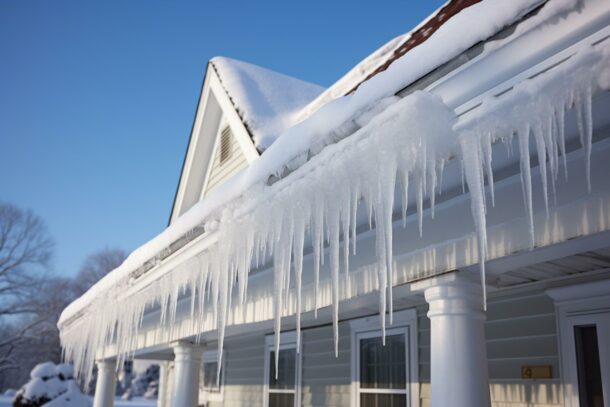
Ice dams can be both a major nuisance and a costly headache for homeowners who live in areas of heavy snowfall during the winter. An ice dam occurs when the snow melts and refreezes on the roof eaves, creating a ridge that blocks water flow from other parts of the roof. This builds up until water begins leaking through the roof. Repairing the damage to ceilings, walls, insulation, and more can be expensive.
However, if a heavy accumulation is already on its way down your gutter line, don’t panic just yet. There are still ways to rectify the situation before it causes further damage. Read more to learn more about ice dams, how they form, and what you can do to prevent their occurrence.
What Are Ice Dams?
They form when air leakage causes ice on a roof to melt and run down its slope to the eave, the roof’s edge extending beyond the house’s exterior walls. When the water reaches the eave, it cools and freezes, forming a ridge of ice along the edge. As more ice melts and flows down, it can become trapped behind the dam, creating a pool of water on the roof. This moisture can seep under shingles, into the attic, and eventually into the living space.
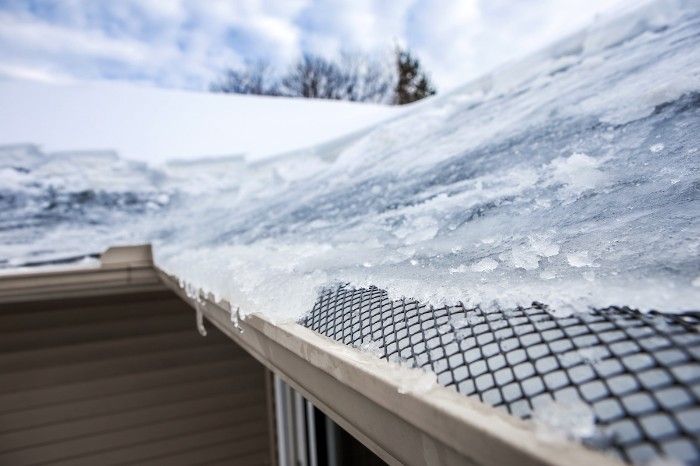
A common cold weather issue, they come at a cost for homeowners. The excess water can cause severe damage to walls, ceilings, insulation, and even electrical systems as it seeps into these areas. Delaying repairs may result in extensive long-term issues, such as mould growth or compromised structural integrity, potentially leading to even higher repair bills.
How Do Ice Dams Form?
Several factors contribute to ice damming. The primary factors are the roof’s temperature and the amount of snow accumulation. Melting snow flows down the slope when the roof’s temperature is above freezing. However, when the cold temperature at the roof’s edge is below freezing, the water freezes and forms an ice dam. The trapped water can seep into the home.
While the weather outside and weather conditions certainly plays a role in ice dam formation, other factors in our homes can worsen the problem. Poor attic insulation and roof ventilation can allow a home’s indoor heat to escape into the attic, which can cause ice to melt. A steep roof pitch can also make it difficult for snow and ice to slide off.
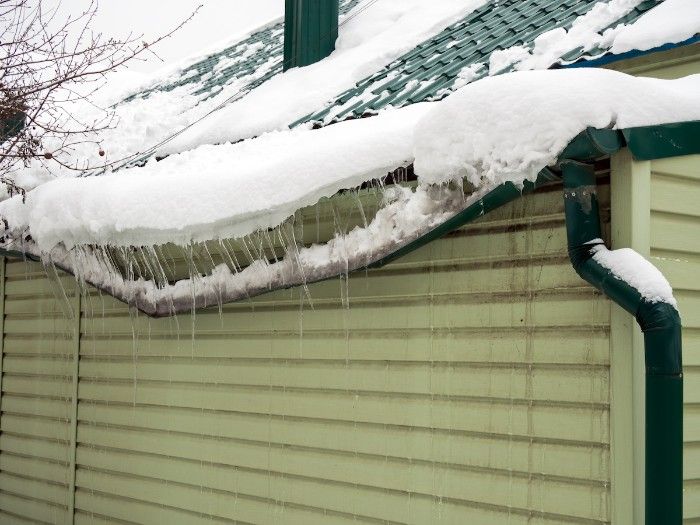
Ice Dams Prevention
Proper insulation and ventilation must be a priority to protect your roof from the perils of ice dams. However, you can take many other steps to ensure your rooftop stays warm and dry throughout Canadian winter! From regular maintenance checks to installing specialized products, ensure you cover all bases for your peace of mind.
Keep Your Roof Clean
Removing snow, ice, and other debris from your roof can be an important preventative measure against disruptive and dangerous ice dam formation. Besides the capacity to damage structures, ice dams can also cause injury if someone slips on any accumulated icy surfaces. Maintaining a clean roof can go a long way.
Install a Water-Repellent Membrane
Put the power of protection on your side by installing a special water-repellent membrane under the roofing shingles. A water-repellent membrane under your roofing shingles is the best way to defend your property against severe damage incurred by melting ice and the subsequent moisture that may follow. The additional layer creates an invisible, impassable ice and water barrier, helping you avoid costly repair bills in the future.
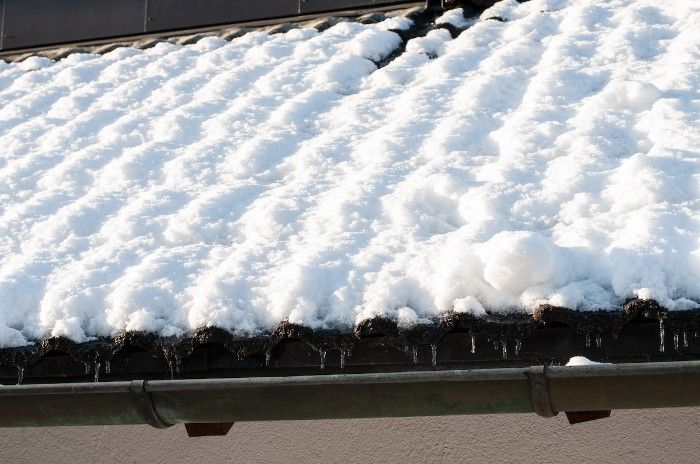
Add Insulation
Insulating your attic is an effective way to maintain a consistent and comfortable temperature in your home. By trapping warm air inside, you’re safeguarding against the threat of ice dams forming along eaves or other vulnerable areas exposed to snowfall. This prevents snow from melting and refreezing at the roof’s edges when the winter chill sets in.
Improve Ventilation
Roof maintenance is a good idea for many reasons, with proper ventilation at the top of the list. In regions with high snow accumulation rates, icy temperatures often prevent snow on roofs from melting away without help. Cold air entering an attic will prevent heat from doing its job and create a risk of ice dams forming. Ice dams can be difficult and dangerous to remove once they appear, so ensuring adequate ventilation can save time and money in the long run.
Install Heat Cables
Heat cables are ideal for homeowners looking to prevent snow and ice from accumulating on their roofs. The cables are easy to install and use electricity to generate heat to melt snow. Less snow on your roof reduces the risk of ice dam damage.
Use Other Ice Dam Prevention Products
Sprinkling products such as rock salt on the roof surface before winter starts can work wonders in preventing any ice from building up on the roof’s edge. In addition to being incredibly effective, it is also an affordable method for homeowners looking for a solution without resorting to more expensive treatments or repairs. When you use a professional-grade product, always follow the label’s directions to avoid misuse.
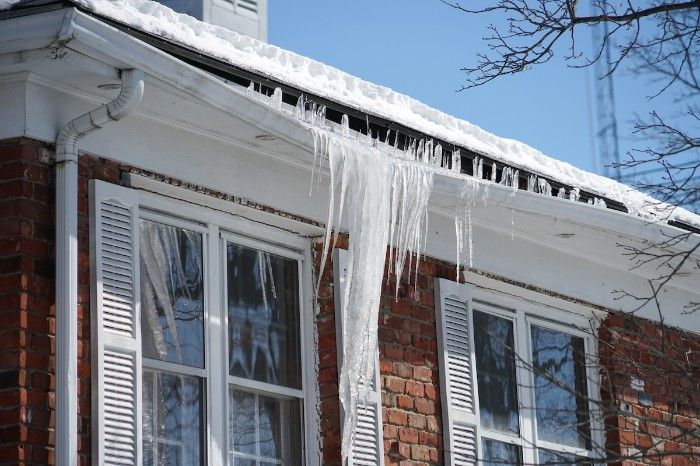
Ice Dam Removal
Be sure to act quickly to shield your home from the devastating effects of ice dams. If you notice an ice dam forming on your roof, there are several steps you can take to prevent damage.
Remove Snow From Your Roof Surface
Removing snow from your roof can be a tedious task that you may want to avoid. However, roof rakes effectively rid your roof of excess snow and prevent ice dams from forming. Utilizing a roof rake to keep your roof snow-free eliminates these risks and ensures your home is safe from damage.
Break Up the Ice Dam
Breaking up an ice dam might be necessary sometimes, but it can be tricky and potentially hazardous. The most effective way to break up the existing ice dam is to use a blunt tool, such as a hammer. However, do take caution, as you don’t want to damage the shingles while doing so. Another option is to try melting the ice with warm water, but this should only be attempted by someone knowledgeable about roof maintenance or a professional roofer. When done correctly, both methods can help reduce the blockage on your roof and protect it from further damage.
Create Channels for Water to Drain
Channels to drain water off the roof from a broken ice dam can be a good option. Removing any excess snow or ice blocking the water flow can guide the melting water away from your property and prevent further pooling or refreezing. Additionally, you can use a hose to melt away any large chunks of remaining ice and open up a safe pathway for the water to follow.
Use a De-Icer
A product like calcium chloride can quickly melt away existing ice and stop new layers from becoming an issue. Before considering this approach, read the manufacturer’s instructions to use the product safely and correctly. Doing your research beforehand means you will avoid any derailments as far as your de-icing efforts go.
Call a Professional
During the cold season, ice dams are hardly a rare occurrence. Fortunately, the best way to prevent further damage to your roof is to contact a professional, depending on the severity and size of your ice dam.
A roofing contractor or an ice dam removal specialist will guarantee a more reliable job and offer comprehensive solutions to prepare your home for future winters. Additionally, they have the right resources and safety gear to avoid any hazards that may come with removing the frozen snow chunks.
Whatever method you opt for, your ice dam problem will be a thing of the past!
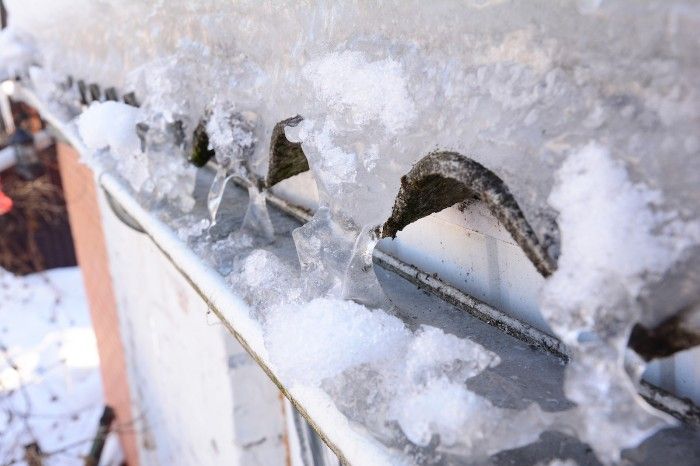
Have Damage Caused By Ice Dams? Call PuroClean Restoration Richmond BC Today!
Ice dams can cause serious property damage, but the good news is that help is only a phone call away. If you have experienced any structural issues, please contact PuroClean Restoration Richmond BC right away. Our skilled technicians will assess the damage, provide cost estimates, and begin restoration so you can return to your routine as quickly as possible. Rest assured that PuroClean Restoration Richmond BC has extensive training and experience restoring homes and businesses affected by ice dams. Call us today at (604) 841-9879.



